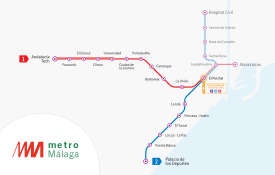Málaga Metro
 | |||
|
| |||
| Overview | |||
|---|---|---|---|
| Native name | Metro de Málaga | ||
| Locale | Málaga, Andalusia, Spain | ||
| Transit type | Rapid transit/Light metro | ||
| Number of lines |
2[1] 4 (planned) | ||
| Number of stations | 17[1] | ||
| Annual ridership | 5 million[2] | ||
| Operation | |||
| Began operation | 30 July 2014[3] | ||
| Operator(s) | Agencia de Obra Pública de la Junta de Andalucía | ||
| Number of vehicles | 14 CAF Urbos 3 | ||
| Technical | |||
| System length | 11.3 km (7.0 mi)[1] | ||
| Track gauge | 1,435 mm (4 ft 8 1⁄2 in) standard gauge | ||
| Top speed | 70 km/h (43 mph) | ||
| |||
The Málaga Metro (Spanish: Metro de Málaga) is a light metro network in Málaga, Spain. It was proposed during the 1990s to ease the crippling congestion when the Ministry of Public Works and Transport commissioned a study in 2001 into the feasibility of constructing a metro system in the city. The plan had four lines, radiating from the city centre, with stations roughly 500 m (1,640 ft) apart to allow a high level of accessibility, with funding for the project coming from both the local and the Spanish governments. The system was originally scheduled to open on 31 October 2013.[4]
Two lines finally opened in service on 30 July 2014.[3]
The current plan is for a total of six lines, connecting the most populated suburbs to the city centre.
Lines
Here are the most important features of the two lines:[1]
| Line | Termini | Length | Stations | Avg. distance between stations (m) | |
|---|---|---|---|---|---|
| El Perchel | Andalucía Tech | 6.7 km (4.2 mi) | 11 | 595 | |
| El Perchel | Palacio de los Deportes | 4.6 km (2.9 mi) | 7 | 608 | |
| Total: | 11.3 km (7.0 mi) | 17[Note 1] | |||
Route
Both lines run underground in the city centre. Line 1 goes from there to the University of Málaga. Between Clínico station and the Andalucía Tech terminus, it runs on the surface,[5] which includes some at-grade intersections.[6]
Line 2 runs entirely underground, from the city centre to the Jose Maria Martin Carpena Arena.[5]
Rolling stock
All trains are Urbos 3, manufactured by the Spanish company Construcciones y Auxiliar de Ferrocarriles. They are fully covered by CCTV and are throughout air-conditioned in an effort to provide security and comfort to a full capacity train car of 56 seated passengers with 170 standing. The capacity figure is accurate for likely peak-time usage, but the trains are also fully accessible to disabled passengers, who may slightly decrease capacity.[5]
The trains are already in successful widespread use in other cities, including 30 on trams in Belgrade, witg 40 are also planned for the Cuiabá system, in Brazil. Málaga's metro, however, represents the largest single order.
References
- ↑ Counting the terminal El Perchel transfer station only once.
Sources
- 1 2 3 4 "Líneas y mapas" [Lines and maps] (in Spanish). Metro Málaga. 2014. Retrieved 2014-08-24.
- ↑ Metro de Málaga. "López anuncia que el Metro de Málaga cumple sus previsiones y transporta 5 millones de usuarios en su primer año" (in Spanish). Retrieved 10 October 2016.
- 1 2 Puente, Fernando (30 July 2014). "Malaga light metro network opens". International Railway Journal. Retrieved 2014-07-30.
- ↑ Costa-news.com. Retrieved 2011-09-26.
- 1 2 3 "Viajar en metro paso a paso" [Travel on the metro step by step] (in Spanish). Metro Málaga. 2014. Retrieved 2014-08-24.
- ↑ "Malaga metro problems - before work's even started". EuroweeklyNews. 27 March 2014. Retrieved 2014-07-30.
External links
![]()
